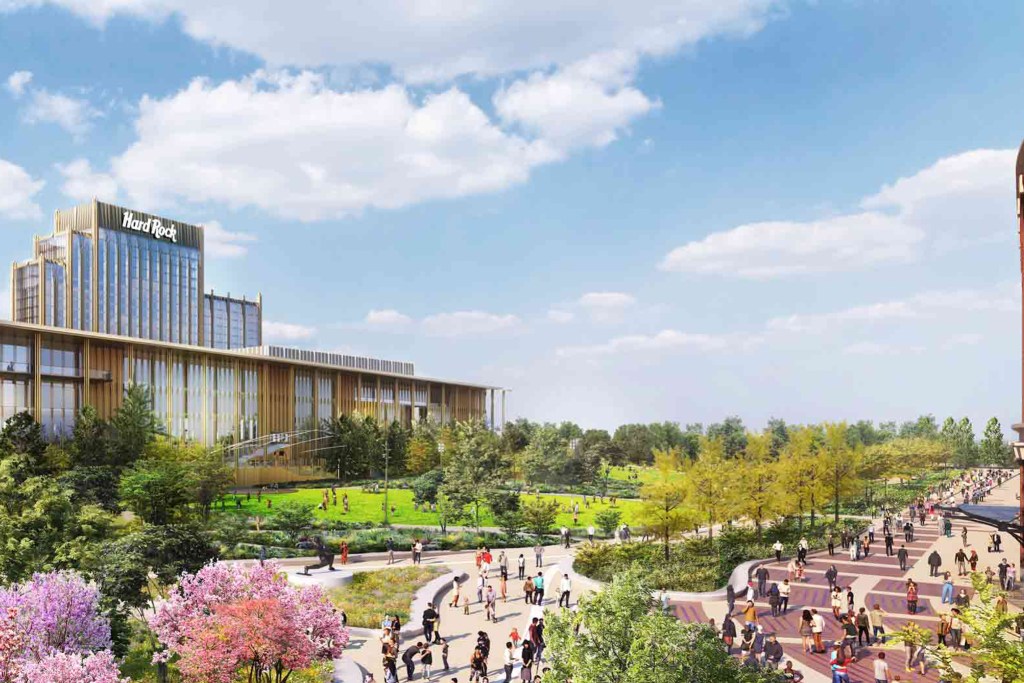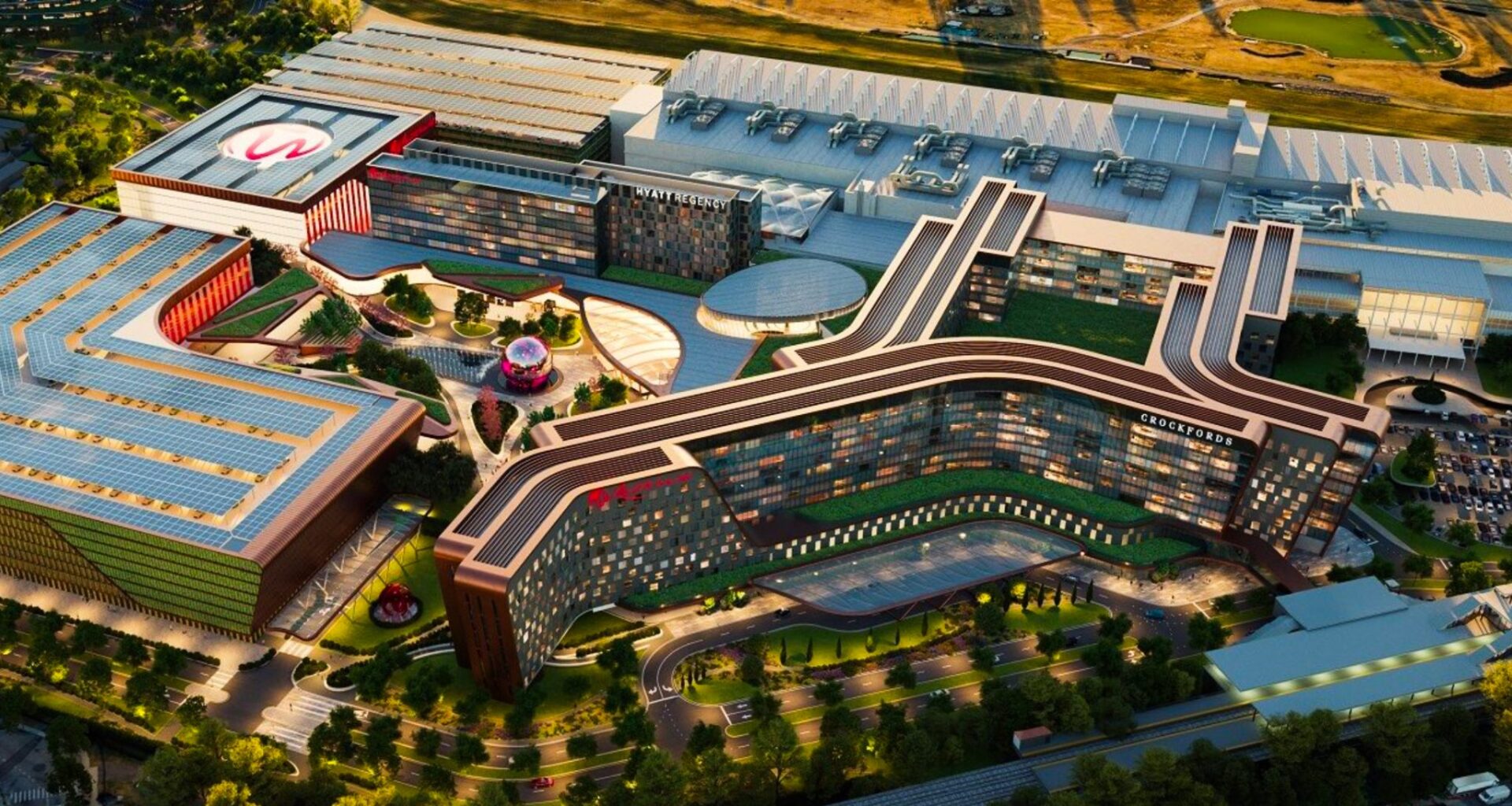The casino proposal process started with eight players, with four surviving a first round of elimination to compete for up to three downstate casino licenses.
Applicants will now be evaluated by the Gaming Facility Location Board and up to three licenses are expected to be awarded by the end of the year.
The jackpot has been years in the making for multiple development teams hoping to hit it big with the state.
While full-fledged casinos are still years away, licensing marks a major step since voters in 2013 approved a ballot measure to amend the state constitution and expand gambling.
Get up to speed on which projects are in the mix, and how the final decision will be made:
Where are the four casino proposals still standing?
The Bronx
Where: Ferry Point, Throggs Neck
Who’s behind it: Bally’s Corporation, which operates 19 casinos in the U.S.
This casino complex would be built on what is now the Bally’s Golf Links at Ferry Point course and would take advantage of its location near the Whitestone Bridge and major highways.It will have parking for close to 5,000 cars, a 500-room hotel, a 2,000-seat event center and half a million square feet for gambling. In a wrinkle stemming from when the golf course was owned by President Donald Trump’s company, if Bally’s is awarded a casino license, the Trump Organization will get $115 million.
Queens
Where: 126th Street, Willets Point near Citi Field, Queens
Who’s behind it: Mets owner and hedge-fund titan Steve Cohen and Hard Rock International.
The backers are pitching a multi-acre resort built near Citi Field with a casino, hotel, a theater, nearly 100,000 square feet of conference space, retail, restaurants and more. It would also include, according to the application, 25 acres of new parkland. In advance, exploratory drilling is underway in a Citi Field parking lot and Albany lawmakers have approved using the state-controlled parkland on which the stadium is built.
 A rendering shows plans for the Metropolitan Park casino next to Citi Field. Credit: Via Hard Rock Hotel & Casino
A rendering shows plans for the Metropolitan Park casino next to Citi Field. Credit: Via Hard Rock Hotel & Casino
Where: 110-00 Rockaway Blvd., Jamaica, Queens
Who’s behind it: The Genting Group, a Malaysia-based hospitality and gaming company that has invested previously in the Foxwoods Resort Casino in Connecticut and the Seneca Niagara Resort & Casino in Niagara Falls.
The operators of the existing Resorts World New York City racino at Aqueduct Racetrack want to expand to a full casino, while also adding a 7,000-seat arena, conference center, 2,000-room hotel and enough parking for 7,000 cars.
The application centers on speed. Since gambling is already in play at the racino,backers are betting that operations could be ramped up within months — offering a faster payday to the state than rival bids.
Westchester
Where: 810 Yonkers Ave., Yonkers
Who’s behind it: MGM Resorts
This proposal would expand the existing Empire City Casino and Yonkers Raceway, adding more gambling space, new restaurants, theaters, meeting halls and a parking garage.
What happens next?
There are a few administrative steps and hoops the developers must clear, most importantly, estimating how much cash each one will rake in.
The Gaming Facility Location Board has asked applicants to submit supplemental material by Oct. 14, including a proposed tax rate on gaming revenue, revenue projections based on three different licensing scenarios, and an estimate of tax revenue the state and city will receive under each scenario as well.
In order for the board to review an application, they must have approval from the CACs (which all four listed above do), prove compliance with state and local zoning requirements, and pay a $1 million dollar application fee to the gaming commission – which will be refunded (minus expenses) if they aren’t selected.
How will the board decide?
The Gaming Facility Location Board will conduct an analysis of the revenue impact of each proposal, evaluating them mostly on economic activity and business development. Some of the objectives they’re evaluating are:
- Maximizing revenues for the state and localities
- Highest number of quality jobs the gaming facility will bring
- A fast and reasonable construction schedule
- Offers a high quality facility and a variety of amenities
- Ability to fully finance the gaming facility
- Experience in developing and operating a quality gaming facility
According to the State Gaming Commission, the Gaming Facility Location Board will recommend up to three winners, but the Commission has the final sign-off. The Commission will not vote on the Board’s recommendations or make their own judgement on it, but will confirm that each applicant meets the following requirements:
- That they can pay the $500 million license fee
- Have secured the land for the development of each project
- Invested $500 million into the gaming facility
- Addressed issues like problem gambling and community impact
The Commission also evaluates the applicants’ integrity, financial stability and history of compliance in other states — requiring developers to prove not only their projects’ financial potential, but that they can be trusted to run them responsibly.
Which project has the best shot at winning?
No one can say for sure, but we have some clues: How much money the applicants have spent to convince elected officials, and how much money they’re promising to bring in from the projects.
The casino applicants have spent years building support for their projects in their communities and with elected officials — and spent big money doing it, too.
In 2024, the proposals spent millions on multiple lobbying firms, dominating the annual list of top clients in New York City. The two organizations working for the casino at Citi Field — Queens Future and New Green Willets — spent $1.8 million last year working with 14 different lobbying firms, according to the City Clerk’s office, which was the highest amount.
Genting LLC, which has the Resorts World proposal, spent just under $1 million with three lobbying firms. And Bally’s spent more than $900,000 on 8 different firms to boost their Bronx bid.
The team behind the proposed Yonkers casino expansion spent around $300,000 in its push for a full license in 2023, according to the New York Post, but wasn’t on a state list for top lobbying clients this year.
The money on lobbying doesn’t include the untold amount the organizations spent throughout neighborhoods working to gain support for the projects.
On the revenue side, Citi Field is the clear winner. Their proposal estimates that Metropolitan Park would bring in $3.9 billion in revenue by its third year, which is way more than any other project projects. It’s also expected to bring $850 million in city and state tax revenue.
However, timing is a factor: the Yonkers and Resorts World projects would be up and running fastest, since they are already operating as gambling facilities. The Citi Field project and the Bronx project wouldn’t open until 2030 at the earliest, the proposals to the state say.
Who’s fighting back to stop the casinos?
Even though Metropolitan Park in Queens made it through the community advisory committee vote, local groups’ efforts to oppose the project have only grown.
Flushing Workers Center, No Casino in Flushing Meadows Corona Park, and 89Street Tenants Unidos are hosting a march in Corona Plaza on Oct. 19 to rally against the proposed project on Citi Field’s parking lot.
The Flushing Workers Center also hosted a march against the casino on Oct. 5.
Throughout the process, Bronx residents voiced concerns and opposition to the Bally’s project at community hearings, but since the advisory vote, there have not been any publicly organized rallying efforts like there have been for Metropolitan Park.
From the getgo, Resorts World in Queens and MGM Empire City have faced less opposition, likely due to the fact that they already operate as racinos, meaning they run a racetrack, slot machines and other non-live table games.
What happens next, and how much money will this bring in for New York?
First, the applicant will have to put down a deposit into the state’s coffers — the exact amount to be determined by the state commission — of no less than 5% and no more than 10%of the project’s total investment.
That’s just a part of a lot more money the license winners will owe the state, because whoever wins one of the coveted casino licenses has to pay the state $500 million for it. They also have to spend a minimum of $500 million in “capital investments” in the area where they will be located, which could mean anything from building subsidized housing to contributing to local transit improvements or creating public park space.
Licensees will also have to answer all requests from the state for information, register its new employees and complete steps to maintain certificates to open to the public.
In addition, the revenue from future gaming will be taxed at a not-yet-determined rate that the gaming board has said will be at least 25% for slot gaming and at least 10% for all other gaming revenue.
According to City Limits, when the state legislature was considering the change, Spectrum Gaming — hired by the state’s gaming board to crunch the numbers on expanding casino downstate — said new gaming facilities in the New York City area would produce $5.5 billion in gross gambling revenue, $841 million a year in tax revenue and create 30,000 jobs in New York.
According to the four proposals on the table now, the developers say together, the projects could create close to 18,000 permanent jobs and around 82,000 indirect and direct construction jobs.
But in a 2023 analysis of the impact of expanding gambling facilities in upstate New York — approved several years earlier — revenue results were a mixed bag. The state comptroller found that though those casinos brought in $176 million for local governments between 2017 and 2022, they did fail to meet their initial revenue and tax projections during that same time period.
“Local gaming revenue is not always a ‘sure bet,’” the report noted. “Careful financial planning is crucial to minimize risk while benefiting from this revenue stream.”
Related
